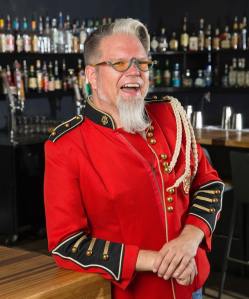By Alyssa Klink
Ten years ago, Marshall Shore, also known to Phoenix as the ‘Hip Historian,’ left his full-time library job to become an Arizona historian. After risking it all to follow his passion, Shore found success in leading ghost tours, doing stand-up shows at places like FilmBar, and taking busloads of tourists to some of Arizona’s most historic cities.
While having coffee with Shore at Songbird, I asked if he knew any antique or vintage stores in the downtown area, to which he replied “Oh! There’s one right here!” So we walked to Antique Sugar, and to no one’s surprise, Shore knew the owner and immediately started up a conversation. It seemed that I could point to any building within eyeshot and he could tell me its history.
Write On Downtown (WOD): How did you make your way to Phoenix?
Marshall Shore (MS): So, I’ve been here 20 years. I grew up in a small Indiana town, and it was a great place to grow up, but that was about it. 25 people, two roads, and so I got myself through college, got my master’s in library science and then moved out to New York City. So I was a librarian in New York for about a decade in Brooklyn Public and New York Public, and then it became obvious it was time for a change…and it was either I make an easy move or go for adventure. And we chose adventure, so hello Phoenix.
WOD: When did you first dip your toes into Arizona history?
MS: I was working at a library in South Phoenix, and as soon as I got to Arizona all I kept hearing was how there’s no history. But at this library in South Phoenix, there was this rich erudition of the community, and I started really listening to that and getting a foundation there. And then as I would talk to people, I realized that nobody was kind of doing that for other neighborhoods. So I just started talking to people, pretty soon they go, ‘well how do you know more about my town than I do?’ And I’m like, ‘cause I talk to people.’
WOD: How did history become your niche?
MS: I think a lot of it, well, it’s really sharing how I fell in love with Arizona. I moved here from New York, this was 20 years ago, and at first I was like, I did what? I moved where? And it really took some time and so really it’s all about finding out what’s happened here that nobody knows about and that we should be talking on a daily basis. And so it’s kind of really sharing how I fell in love with Arizona, so it’s really connecting people to place.
WOD: How did you get the name Hip Historian?
MS: During our centennial, Arizona celebrated 100 years of statehood back in 2012. I was asked to present on the main stage at the State Capital, on February 14. It was a star studded affair with lots of folks sharing AZ stories. The Director of Tourism, Karen Churchard, was describing me to someone who had confused Marshall Trimble, the State Historian, and myself. She said “he is the Hip Historian.” I loved it so much that I thanked her and took it as my moniker. My website is http://www.HipHistorian.com.

WOD: What is your favorite aspect of Phoenix’s history?
MS: You never know where the next piece of a story is coming from. My best sources are people. They will talk and mention things that might not be well known, or even connect people and/or places.
WOD: What are the challenges to your job?
MS: There’s so much history. Researching one thing and coming across another noteworthy story. Storing it away to bring it forward and devote time and resources when able to. Sometimes you never know who or what will have the next piece of story. So, when I am obsessed with a topic, I talk to everybody I meet about it. Sometimes I’m surprised about the random connections. You’ve heard of 6 degrees of separation, I like to call it two-degrees here in the valley. It was a small town, even though it’s growing to be the 5th/4th largest city in the US, in many ways it still is a small town.
WOD: How has Phoenix’s history shaped its art and culture scene?
MS: Visit South Mountain: a park that has easily accessible petroglyphs, or rock art. People writing on walls to document what was happening. The landscape has attracted a variety of folks including creatives. 1986 brought Keith Haring here for an exhibit at the Phoenix Art Museum. He noticed a lack of public art, and that resulted in a large mural, now lost. That mural also was completed with assistance from South Mountain High School, still an Arts Magnet school. His visit sparked locals to create art and I think is a huge piece of why we are having a resurgence of murals.
WOD: Why is Phoenix’s history worth learning and knowing?
MS: Phoenix is layered with history. Sometimes the history can be hard to find, but it really connects us to this place and the folks who came before us. That made this state what it is and why it’s so special and unique.